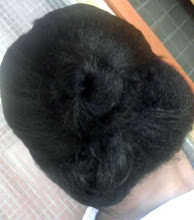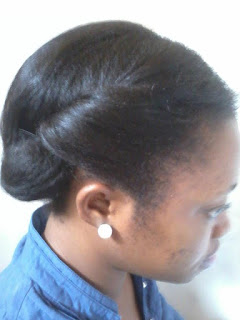-->
Properly "texlaxing," or gently underprocessing, your hair is an art. But done correctly, texlaxing can be extremely beneficial to your hair. This article will describe techniques for "texlaxing" your hair to perfection every single time.
What is Texlaxing?
"Texlaxed" hair is a term that was coined in the Internet hair world to describe a hair texture that falls between texturized curls and chemically relaxed, straight hair. "Texlaxing" is the intentional underprocessing of hair with a relaxer chemical, and is typically done to create volume, body, and texture in relaxed hair.
Popular Texlaxing Methods
There are many methods for texlaxing the hair, and most center around reducing initial disulfide bond breakage in the hair fiber. Disulfide bonds are the bonds that cause our hair to have a naturally curly, or kinky texture. Breaking these bonds prepares them for straightening in the smoothing stage of the relaxer.
An alternative texlaxing method involves simply skipping the official disulfide bond straightening process. Texlaxing methods can be used alone or in combination to achieve various degrees of textured, relaxed hair results.
1. Adding a teaspoon of oil to the relaxer slows down the processing of the hair, that is reduces the potency of the relaxer to get the hair straight. You mix the oil only in the relaxer you are going to apply and not the whole jar or box. You can use olive oil, coconut oil or any light oil.
2. Adding a teaspoon or two of regular conditioner to the relaxer slows the process too.
3. Coat your hair with thick butter such as sheabutter or Vaseline to prevent the relaxer from fast processing.
4. The last one is to reduce the time the relaxer sits on the hair or not smooth the hair for long.
Any of these techniques can work but you will have to determine the texture you want as well as being consistent to get the same results all the time (not really possible though).
What is Texlaxing?
"Texlaxed" hair is a term that was coined in the Internet hair world to describe a hair texture that falls between texturized curls and chemically relaxed, straight hair. "Texlaxing" is the intentional underprocessing of hair with a relaxer chemical, and is typically done to create volume, body, and texture in relaxed hair.
Popular Texlaxing Methods
There are many methods for texlaxing the hair, and most center around reducing initial disulfide bond breakage in the hair fiber. Disulfide bonds are the bonds that cause our hair to have a naturally curly, or kinky texture. Breaking these bonds prepares them for straightening in the smoothing stage of the relaxer.
An alternative texlaxing method involves simply skipping the official disulfide bond straightening process. Texlaxing methods can be used alone or in combination to achieve various degrees of textured, relaxed hair results.
1. Adding a teaspoon of oil to the relaxer slows down the processing of the hair, that is reduces the potency of the relaxer to get the hair straight. You mix the oil only in the relaxer you are going to apply and not the whole jar or box. You can use olive oil, coconut oil or any light oil.
2. Adding a teaspoon or two of regular conditioner to the relaxer slows the process too.
3. Coat your hair with thick butter such as sheabutter or Vaseline to prevent the relaxer from fast processing.
4. The last one is to reduce the time the relaxer sits on the hair or not smooth the hair for long.
Any of these techniques can work but you will have to determine the texture you want as well as being consistent to get the same results all the time (not really possible though).


Comments
Post a Comment
Speak your mind; I love to hear from you!